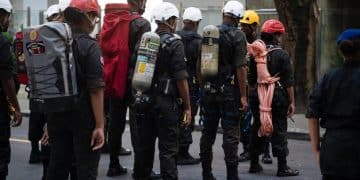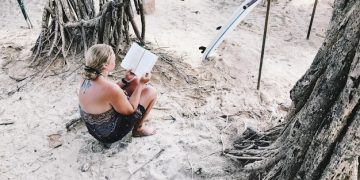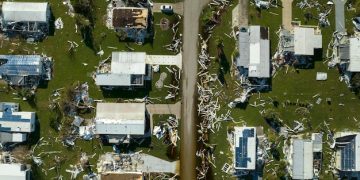Mental Health Resources: Coping with Disaster’s Psychological Impact in the US

Mental health resources are crucial for individuals in the US coping with the psychological impact of disasters, offering support, guidance, and strategies to navigate trauma, grief, and stress during and after such events.
Disasters, whether natural or human-caused, can leave a lasting mark on the mental well-being of individuals and communities. Accessing the right mental health resources: coping with the psychological impact of disasters in the US is paramount for recovery and resilience.
Understanding the Psychological Impact of Disasters
Disasters can trigger a range of psychological responses, from anxiety and depression to post-traumatic stress disorder (PTSD). Recognizing these potential impacts is the first step in seeking appropriate support and fostering resilience.
The psychological impact of disasters can vary widely among individuals, depending on factors such as the severity of the event, personal experiences, pre-existing mental health conditions, and available support systems. Understanding these factors is crucial for tailoring effective mental health interventions.
Common Psychological Responses to Disasters
Disasters often lead to a number of psychological responses. Being aware of them can help communities proactively offer aid.
- Anxiety and Fear: Heightened levels of anxiety and fear are common, often related to concerns about safety, security, and the future.
- Depression and Grief: The loss of loved ones, homes, and livelihoods can trigger feelings of sadness, hopelessness, and grief.
- Post-Traumatic Stress Disorder (PTSD): Exposure to traumatic events can lead to PTSD, characterized by intrusive thoughts, nightmares, flashbacks, and emotional numbing.
- Substance Abuse: Some individuals may turn to alcohol or drugs as a way to cope with the stress and trauma associated with disasters.
Addressing these psychological responses requires a comprehensive approach that combines immediate crisis intervention with long-term mental health care. Early intervention can prevent the escalation of symptoms and promote resilience.

Immediate Mental Health Support After a Disaster
In the immediate aftermath of a disaster, providing psychological first aid and emotional support is crucial. These interventions can help individuals stabilize their emotions, connect with resources, and begin the process of recovery.
Organizations like the American Red Cross and the Substance Abuse and Mental Health Services Administration (SAMHSA) offer immediate mental health support services after disasters. These services are designed to provide rapid assistance to those in need.
Psychological First Aid (PFA)
Psychological First Aid (PFA) is an evidence-based approach that aims to reduce distress and promote adaptive coping in the immediate aftermath of a disaster.
- Safety and Security: Ensuring the safety and security of individuals affected by the disaster is the first priority.
- Emotional Support: Providing a calm and supportive presence can help individuals feel more secure and less overwhelmed.
- Practical Assistance: Offering practical assistance, such as connecting individuals with resources for food, shelter, and medical care, can reduce stress and promote coping.
- Information and Education: Providing accurate and timely information about the disaster and available resources can help individuals make informed decisions and take appropriate action.
PFA is designed to be delivered by trained professionals and volunteers who can provide support in a culturally sensitive and compassionate manner. It is an essential component of disaster response and recovery efforts.
Long-Term Mental Health Resources and Treatment Options
While immediate support is critical, long-term mental health care is often necessary for individuals who experience lasting psychological effects from disasters. A range of treatment options and resources are available to support recovery and promote well-being.
Accessing long-term mental health resources can be challenging for some individuals, particularly those in underserved communities. Addressing these barriers is essential for ensuring that everyone has access to the care they need.
Therapy and Counseling
Therapy and counseling can provide individuals with a safe and supportive space to process their experiences, develop coping strategies, and heal from trauma.
- Cognitive Behavioral Therapy (CBT): CBT is an effective treatment for PTSD and other anxiety disorders. It helps individuals identify and change negative thought patterns and behaviors.
- Eye Movement Desensitization and Reprocessing (EMDR): EMDR is a therapy technique that can help individuals process traumatic memories and reduce their emotional impact.
- Group Therapy: Group therapy provides a supportive environment where individuals can share their experiences, connect with others who have gone through similar events, and learn coping strategies.
These therapeutic interventions can be tailored to meet the specific needs of individuals affected by disasters, providing a pathway to healing and recovery. Teletherapy options are also increasingly available, expanding access to mental health care for those in remote or underserved areas.
Building Community Resilience Through Mental Health Support
Promoting mental health and well-being at the community level is essential for building resilience and fostering long-term recovery after disasters. Community-based initiatives can help reduce stigma, increase access to resources, and create supportive environments.
Community resilience involves the ability of a community to withstand and recover from adversity. Integrating mental health support into community planning and response efforts is crucial for building resilience.
Community-Based Mental Health Programs
Community-based mental health programs can play a vital role in promoting mental health and well-being after disasters.
These programs include:
- Mental Health Education and Awareness Campaigns: Raising awareness about mental health issues and reducing stigma can encourage individuals to seek help when they need it.
- Support Groups: Facilitating support groups can provide individuals with a sense of community and connection, helping them feel less alone in their struggles.
- Training Programs for Community Leaders: Training community leaders and volunteers in psychological first aid and mental health awareness can increase the capacity of the community to respond to the mental health needs of its residents.

The Role of Government and NGOs in Providing Mental Health Resources
Government agencies and non-governmental organizations (NGOs) play a critical role in providing mental health resources and support after disasters. Their efforts range from providing immediate crisis intervention to supporting long-term recovery and resilience initiatives.
Effective coordination between government agencies, NGOs, and community organizations is essential for ensuring a comprehensive and coordinated response to the mental health needs of disaster-affected populations.
Key Government Agencies and NGOs
Several government agencies and NGOs are key players in providing mental health resources after disasters.
Examples are:
- Substance Abuse and Mental Health Services Administration (SAMHSA): SAMHSA provides funding, technical assistance, and training to support mental health and substance abuse services across the United States.
- Federal Emergency Management Agency (FEMA): FEMA provides disaster relief and recovery assistance, including funding for mental health services.
- American Red Cross: The American Red Cross provides immediate disaster relief, including psychological first aid and emotional support.
- National Alliance on Mental Illness (NAMI): NAMI provides education, support, and advocacy for individuals and families affected by mental illness.
Accessing Mental Health Resources: Overcoming Barriers and Challenges
Despite the availability of mental health resources, many individuals face barriers to accessing care after a disaster. These barriers can include financial constraints, lack of insurance coverage, stigma, cultural factors, and geographic limitations.
Addressing these barriers is essential for ensuring that everyone who needs mental health support can access it. Creative solutions and innovative approaches are needed to overcome these challenges.
Strategies for Overcoming Barriers
Several strategies can help overcome barriers to accessing mental health resources after a disaster.
- Increasing Awareness: Raising awareness about the availability of mental health resources and reducing stigma can encourage individuals to seek help.
- Expanding Insurance Coverage: Advocating for expanded insurance coverage for mental health services can reduce financial barriers to care.
- Providing Telehealth Options: Offering telehealth options can increase access to care for individuals in remote or underserved areas.
- Addressing Cultural Barriers: Tailoring mental health services to meet the cultural needs of diverse populations can improve engagement and outcomes.
| Key Point | Brief Description |
|---|---|
| 🚨 Immediate Support | Psychological First Aid (PFA) helps stabilize emotions and connect individuals with immediate resources. |
| 👩⚕️ Long-Term Care | Therapy, counseling, and support groups offer pathways for processing trauma and developing coping strategies. |
| 🏘️ Community Resilience | Community-based programs, education, and support groups foster resilience and reduce stigma. |
| 🤝 Government & NGOs | SAMHSA, FEMA, and organizations like the Red Cross offer vital mental health resources and disaster relief. |
FAQ
▼
Common reactions include anxiety, fear, depression, grief, and PTSD. Some individuals may also turn to substance abuse as a coping mechanism. Recognizing these reactions is crucial for seeking appropriate support.
▼
PFA is an evidence-based approach to reduce distress and promote adaptive coping in the immediate aftermath of a disaster. It focuses on ensuring safety, providing emotional support, and offering practical assistance.
▼
Community programs raise awareness, reduce stigma, and create supportive environments. Support groups and training programs for community leaders enhance the community’s capacity to respond to mental health needs.
▼
Government agencies like SAMHSA and FEMA, along with NGOs like the American Red Cross, provide critical mental health resources, funding, and disaster relief, supporting both immediate crisis intervention and long-term recovery.
▼
Barriers include financial constraints, lack of insurance, stigma, cultural factors, and geographic limitations. Strategies to overcome these include increasing awareness, expanding insurance coverage, and providing telehealth options.
Conclusion
Accessing and utilizing mental health resources: coping with the psychological impact of disasters in the US is crucial for fostering individual and community resilience. By understanding the psychological effects of disasters, providing immediate support, and ensuring access to long-term care, we can help those affected heal and rebuild their lives.





